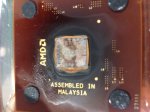corv
Dabbler
- Joined
- Jul 31, 2014
- Messages
- 25
Hello folks,
I've been a happy FreeNAS user for a couple of years now. Originally a longtime Linux fan, I'm starting to lean more towards the BSDs. Once again it's time for me to start thinking about a new server.
I've checked the forums and found a wealth of new information (big thanks goes to Cyberjock) and yet there are still some questions I have before I start ordering any components.
I've been offered 1U (possibly 2U) of rack space and would like to consolidate a rented dedicated server and a couple of VPS into a server backed by ZFS.
I won't be able to drive to the server quickly so I'm looking for a reliable solution where components can be easily replaced by technicians at the facility if necessary. An efficient or low-power solution would also be preferable as long as performance isn't severely limited.
I've been looking at this Avoton SoC from Supermicro as one possible option:
http://www.supermicro.com/products/motherboard/Atom/X10/A1SAM-2750F.cfm
It's only marginally more expensive than the popular ASRock SoC and makes a more reliable impression.
Would it be underpowered for a couple of jails and a VM or two running several low-traffic websites (python, ruby, php, node.js, postgresql, mysql, mongodb), smtp & imap, vpn, rsync? I was planning to use 32GB ECC from the start.
Is an i3 a better choice or would a 4-core Avoton suffice?
Since the SoC has 6x SATA would it make more sense to run the jails and VMs on two mirrored SSDs and then use the remaining 4 SATA for HDDs with RAIDZ2? How difficult will it be to ensure that the mirrored SSDs running live OSes are properly backed up to the RAIDZ2 pool? Is there any TRIM support? Are the SSDs unnecessary and would it therefore be far more economical and simpler to use 6 HDDs with RAIDZ2?
Supermicro offers some cases with redundant PSUs but I've never used any. Since I've had bad experiences with defective PSUs I'd like to make a sensible choice even if it means spending some more money. Do the redundant PSUs need to be supported by the OS or motherboard? Do they kick in automatically when something is amiss?
As this is more than just a storage appliance, is there any reason to use vanilla FreeBSD instead of FreeNAS?
Any comments & criticism are highly appreciated.
Thanks for reading.
I've been a happy FreeNAS user for a couple of years now. Originally a longtime Linux fan, I'm starting to lean more towards the BSDs. Once again it's time for me to start thinking about a new server.
I've checked the forums and found a wealth of new information (big thanks goes to Cyberjock) and yet there are still some questions I have before I start ordering any components.
I've been offered 1U (possibly 2U) of rack space and would like to consolidate a rented dedicated server and a couple of VPS into a server backed by ZFS.
I won't be able to drive to the server quickly so I'm looking for a reliable solution where components can be easily replaced by technicians at the facility if necessary. An efficient or low-power solution would also be preferable as long as performance isn't severely limited.
I've been looking at this Avoton SoC from Supermicro as one possible option:
http://www.supermicro.com/products/motherboard/Atom/X10/A1SAM-2750F.cfm
It's only marginally more expensive than the popular ASRock SoC and makes a more reliable impression.
Would it be underpowered for a couple of jails and a VM or two running several low-traffic websites (python, ruby, php, node.js, postgresql, mysql, mongodb), smtp & imap, vpn, rsync? I was planning to use 32GB ECC from the start.
Is an i3 a better choice or would a 4-core Avoton suffice?
Since the SoC has 6x SATA would it make more sense to run the jails and VMs on two mirrored SSDs and then use the remaining 4 SATA for HDDs with RAIDZ2? How difficult will it be to ensure that the mirrored SSDs running live OSes are properly backed up to the RAIDZ2 pool? Is there any TRIM support? Are the SSDs unnecessary and would it therefore be far more economical and simpler to use 6 HDDs with RAIDZ2?
Supermicro offers some cases with redundant PSUs but I've never used any. Since I've had bad experiences with defective PSUs I'd like to make a sensible choice even if it means spending some more money. Do the redundant PSUs need to be supported by the OS or motherboard? Do they kick in automatically when something is amiss?
As this is more than just a storage appliance, is there any reason to use vanilla FreeBSD instead of FreeNAS?
Any comments & criticism are highly appreciated.
Thanks for reading.


